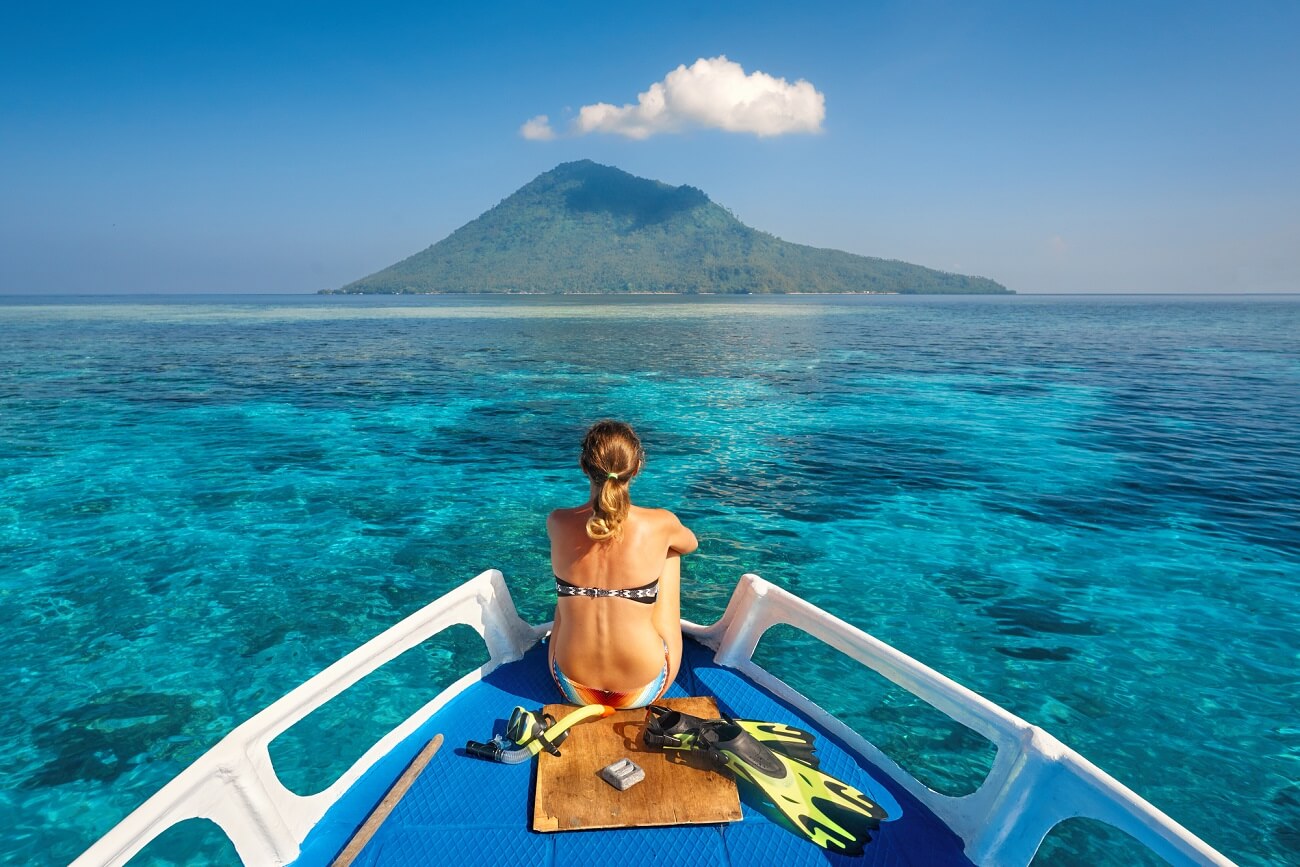

In Indonesia, the land of thousands of islands, is Komodo National Park, a UNESCO World Heritage Site. It is the only place in the world where you can encounter the legendary Komodo dragons in their natural habitat.
Komodo dragons, known for their size, sharp teeth, and long tongues, are found only on a few remote volcanic islands in Southeast Asia. In the wild, only 3400 Komodo dragons remain. They live on 5 islands, dubbed Jurassic Park in Indonesia. This is about 1400 adult Komodo dragons and 2000 young individuals. Although dragons are found on the islands of Komodo, Rinca, Gili Montang, Gili Dasami, and Flores, most of them live on Komodo and Rinca.

Depositphotos
History of the appearance of Komodo dragons
Komodo dragons have captured the human imagination for more than 100 years. In the early 20th century, rumors circulated of dragon-like lizards living in Southeast Asia, which is why they were called "dragons". In 1910, a Dutch officer named Jacques Karel Henri van Steyn van Hensbroek set out to investigate this issue and discovered that the rumors were true. He managed to photograph a Komodo dragon and obtain Komodo skin to prove their existence to the world.
Experts recently discovered that Komodo dragons actually came from Australia and migrated to Indonesia about 900,000 years ago, when the two countries were still connected by land. Their existence is now threatened by human intervention. It is predicted that the number of tourists will grow in geometric progression in the coming decades along with climate change: wild Komodo dragons may be at risk.

Depositphotos
Facts about Komodo dragons
- Komodo is called dragons, but of course they have nothing in common with them. Dragons in European mythology are huge fire-breathing creatures with strong scales. In Eastern cultures, dragons are usually considered snake-like creatures that bring good luck or prosperity and can sometimes control the elements. In the case of Komodo, these are reptiles with thick skin, strong claws, sharp teeth. They somewhat resemble the image of dragons. Komodo dragons are large, long, and dangerous. They can smell blood at a distance of 10 km and can travel 20 km/h.
- Adult Komodo dragons are some of the largest and heaviest lizards on Earth. In the wild, these scaly giants usually weigh about 70 kilograms. The largest confirmed specimen reached a length of three meters and weighed 166 kg. The reason they are so massive is explained by "island gigantism": simply in their habitat there are no competing predators. But this is one of the reasons they may disappear: Komodo dragons don't like to travel far, and loss of habitat could be even more harmful to them.
- Komodo dragons eat all kinds of animals, including chickens, pigs, deer, smaller dragons, and buffalo. The majority of the Komodo dragon's diet consists of carrion or decaying flesh of dead animals. Young individuals feed mainly on small lizards and insects, snakes, and birds. When they become older and larger, they switch to larger prey, such as rodents, monkeys, goats, wild boars, and deer (their favorite food). They can eat 80% of their weight in one meal and then not eat again for several months. Females sometimes eat their own children.
- The average lifespan of Komodo dragons in the wild is about 30 years. In captivity, lifespan ranges from 20 to 30 years. Factors such as habitat conditions, food availability, and overall health can affect the lifespan of these amazing creatures.
- Komodo dragons have very poor hearing. Despite this, they have a unique hearing mechanism. Their range is limited to 400-2000 Hertz, unlike humans who can hear a wider range from 20 to 20,000 Hertz.
- According to the International Union for Conservation of Nature, they do not like to climb above 700 m above sea level, but rising temperatures and sea levels will affect 30% of the islands on which they live.
- Komodo dragons hold a special place in Indonesian culture. They have also become an important tourist attraction, attracting visitors who want to see these magnificent creatures in their natural habitat.
- A keen sense of smell plays a crucial role in finding food over considerable distances. Surprisingly, Komodo dragons' vision is not their strongest sense, but they compensate with their ability to use their long forked tongue to capture scent particles in the air.
A remarkable feature of female Komodo dragons is their ability to reproduce without mating. This reproductive phenomenon, known as parthenogenesis, allows them to lay viable eggs that develop into healthy offspring. By bypassing the need for male fertilization, female Komodo dragons ensure the survival and continuation of their species even in the absence of available male partners. Female Komodo dragons exhibit maternal instinct when it comes to protecting their eggs. They carefully construct a nesting burrow, where they lay a clutch of approximately 20 eggs. After the female dragon lays the eggs—usually 15 to 30 at a time, each the size of a grapefruit—incubation takes up to eight months. The sex of the Komodo dragon's offspring is determined by the egg incubation temperature. Higher temperatures result in the hatching of male dragons, while lower temperatures result in the hatching of female offspring. When Komodo dragons first hatch, they weigh about 100 grams, average length—40 centimeters. They are vulnerable and must live in trees for the first few years of their lives to avoid being killed. Around 5 years old, young Komodo dragons become large enough to stand up for themselves and descend. These magnificent creatures take approximately 8-9 years to reach sexual maturity, a significant milestone in their life cycle. As adults, they can live for more than 30 years in the wild, giving them enough time to establish dominance in their habitat. Their presence helps regulate the population of prey species, ensuring the health and stability of the ecosystem.

Depositphotos
Danger of Komodo for tourists
A Komodo dragon attack can be fatal even for humans.
Compared to crocodiles and other reptiles, Komodo dragons have a relatively weak bite force. Instead, they rely on their sharp curved teeth and long strong claws to tear their prey with astonishing force. After biting, they use powerful neck muscles to violently shake the victim from side to side, tearing flesh and causing severe blood loss and shock.
The killing power of the Komodo dragon is enhanced by a combination of secondary weapons: venom and bacteria. Researchers have also discovered a venom gland in the lower jaw of the dragon. This venom prevents the victim's blood from clotting, causing massive blood loss and shock. Even larger prey animals, such as water buffalo, can die from wounds after escaping the initial attack, although it may take days.
Komodo dragons have attacked and killed people before, although this does not happen often.
- Since 1987, there have been 16 Komodo dragon attacks on humans and four cases of death.
- In 1990, a tourist went sunbathing, and he was never seen again. All that was found was a camera and some sunglasses. Locals assumed that he was eaten by Komodo dragons.
- In 2007, a young man went to the toilet behind a bush and was killed by a Komodo dragon.
- In 2009, a man fell from a tree and was killed by two Komodo dragons waiting below.
Despite the predatory nature of Komodo dragons, guides still lead tourists around the islands so they can see them. They are armed with nothing more than a large stick to keep them at a distance.
Incidentally, Komodo dragons are not alone on the islands. Local residents live there too. Locals say they've gotten used to it and that they scare off the dragons the same way you chase away a squirrel.

Depositphotos
Komodo National Park
Komodo National Park is the only place in the world where you can see Komodo dragons in the wild. It is a UNESCO World Heritage Site located in the southern part of the Pacific Ocean on the eastern edge of Indonesia.
The Indonesian government created the park in 1980 to protect wildlife, banning hunting and fishing on 29 islands.
Labuan Bajo, once a small fishing town on the tip of Flores island, is the gateway to the national park. The islands here are known for their remoteness, ruggedness, and beauty.
One of the easiest ways to get there is a one-hour flight from Bali.
The Komodo National Park tour should begin with Flores island, which can be reached by ferries and buses or by plane. Since Komodo dragons are under reliable protection, you will need permission to enter the park and a visit to a travel agency. Many different boat tours are available.
Don't miss your opportunity to see Indonesian dragons. These huge lizards have become a national symbol of biodiversity and natural beauty in Indonesia, attracting travelers from all over the world!

Depositphotos
More articles
- Bali's Best Beach Clubs - 13 Luxury Oases
- Tips for tourists in Indonesia - how to avoid spoiled holidays
- Yoga Studios in Bali - where to catch Zen on the Island of the Gods
- Port Louis: All About Mauritius' Capital
- Seychelles Honeymoon Hotels: 9 Paradise Spots
- Bali's Best Eco-Hotels: Top 12 Spots
- Seychelles for outdoor activities - from diving to jungle trekking
- Why you can be deported from Bali - several main reasons
- Seychelles hotels with the best panoramic views
- UNESCO sites in Indonesia: temples, parks and other amazing places



